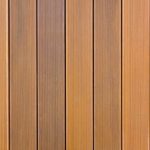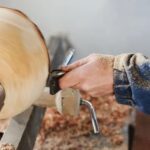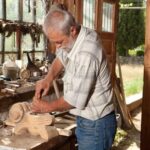Are you looking to learn how to make table top woodworking? Table top woodworking is the process of creating a wooden table surface, from choosing the right wood and tools, designing and planning, to joinery techniques and finishing. This article will provide an in-depth guide on how to embark on this woodworking journey.
Table top woodworking holds great significance in the world of furniture making as it plays a vital role in creating beautiful and functional furniture pieces. A well-crafted table top not only adds aesthetic value to a piece of furniture but also provides a sturdy and reliable surface for various purposes. Whether you are a beginner or an experienced woodworker, mastering the art of table top woodworking is a valuable skill that can elevate your craftsmanship to new heights.
In this article, we will delve into the various aspects of table top woodworking, starting with choosing the right wood for your project. We will discuss different types of wood suitable for tabletops and their unique qualities and characteristics.
Additionally, we will explore the essential tools and equipment needed for table top woodworking, including saws, sanders, and clamps. With this comprehensive guide, you will be equipped with all the knowledge needed to create stunning tabletops through the timeless art of woodworking.
Choosing the Right Wood
When it comes to table top woodworking, choosing the right wood is crucial in creating a beautiful and durable piece of furniture. There are several types of wood that are suitable for table top woodworking, each with its own unique qualities and characteristics. Here are some popular choices:
- Oak: Known for its strength and distinctive grain patterns, oak is a popular choice for table tops. It is also resistant to moisture and rot, making it ideal for furniture that will be used frequently.
- Walnut: Walnut wood has a rich, dark color and a smooth texture, making it a favorite for tabletops. It is also known for being easy to work with and can be finished to create a stunning polished look.
- Maple: Maple wood is prized for its durability and light color, which makes it versatile for different styles of tables. It is also relatively affordable compared to other hardwoods.
These are just a few examples of the many types of wood available for table top woodworking. When choosing the right wood for your project, consider factors such as the desired aesthetic, durability, and budget.
It’s important to note that different types of wood require different levels of care and maintenance. Some may need regular sealing or oiling to maintain their appearance and protect them from wear and tear over time. Consider these factors when selecting the right wood for your tabletop project.
Overall, understanding the qualities and characteristics of different types of wood will help you make an informed decision when embarking on your table top woodworking project. By choosing the right wood, you can ensure that your finished piece not only looks beautiful but also stands the test of time.
Tools and Equipment
When it comes to table top woodworking, having the right tools and equipment is crucial to achieving a professional and polished finish. Here is a detailed list of essential tools and equipment needed for table top woodworking:
1. Circular saw: A circular saw is essential for cutting large pieces of wood down to size for your table top. It allows for precise and straight cuts, making it an indispensable tool in any woodworker’s arsenal.
2. Belt sander: Once the wood pieces are cut, a belt sander comes in handy for smoothing out rough edges and achieving a consistent surface. It is important to ensure that the tabletop is perfectly flat and level, and a belt sander can help achieve this.
3. Clamps: Clamps are essential for holding wood pieces together during the assembly process. They come in various sizes and types, including bar clamps, pipe clamps, and spring clamps, and are necessary for keeping everything in place while glue dries or joinery techniques are used.
4. Router: A router is useful for creating decorative edges or patterns on the tabletop surface. It can also be used for joinery techniques such as creating dovetail joints or rabbet joints.
5. Drill press: A drill press is useful for creating precise holes in the tabletop surface for things like attaching legs or hardware. This tool ensures accurate drilling angles and depths.
These essential tools are just the foundation of what you’ll need to create stunning table tops through woodworking. Additionally, having high-quality measuring tools such as tape measures, squares, and levels will ensure accuracy throughout the entire process of building your tabletop.
Using all these tools efficiently requires knowledge of their correct usage and proper safety measures. Before diving into your project, make sure you have a comprehensive understanding of how to make table top woodworking using these essential tools to avoid accidents and achieve the best results possible.
Design and Planning
When it comes to making table top woodworking, the design and planning phase is crucial. Before you start any construction, it’s essential to have a clear vision of what you want your table top to look like. The first step in this process is conceptualizing the design. This includes considering the overall style of the table – whether it be modern, rustic, traditional, or something else – as well as any specific features or details you want to incorporate.
After conceptualizing the design, the next step is planning the size and shape of the table top. This involves taking precise measurements and determining the dimensions that best suit your needs and space. Factors to consider include how many people you want the table to accommodate, as well as any specific spatial constraints in your home or office.
In addition to size and shape, it’s important to think about style when designing a table top. Consider the aesthetic of your space and choose a style that complements it. Whether you’re going for a sleek minimalist look or a more ornate design, selecting a style that harmonizes with your existing decor will help ensure that your finished piece looks right at home.
| Tabletop Design Considerations | Key Points |
|---|---|
| Conceptualizing Design | Consider overall style and specific details |
| Size and Shape | Determine dimensions based on needs and space constraints |
| Style | Select a style that complements existing decor |
Joinery Techniques
Another common joinery technique is mortise and tenon, which involves creating a square or rectangular hole (mortise) in one piece of wood that matches a protrusion (tenon) on the other piece. This type of joint provides excellent support and resistance to racking forces, making it ideal for table tops where stability is crucial. Understanding how to use mortise and tenon joinery in table top woodworking can result in a strong and reliable construction.
Pocket hole joinery has gained popularity for its simplicity and ease of use in joining tabletop pieces together. It involves drilling an angled hole into one workpiece with a special jig, then joining it to another workpiece using a self-tapping screw. This technique is versatile and can be used for various types of joints, making it a convenient option for beginners learning how to make table top woodworking.
| Joinery Technique | Description |
|---|---|
| Dovetail Joinery | Interlocking tails and pins at right angles |
| Mortise and Tenon Joinery | Square or rectangular hole (mortise) with matching protrusion (tenon) |
| Pocket Hole Joinery | Angled holes drilled into workpieces joined with self-tapping screws |
Surface Preparation
Choosing the Right Sandpaper
Before starting the sanding process, it’s important to choose the right sandpaper grit for the job. Coarse grit sandpaper, such as 60-80, is ideal for removing old finishes and imperfections on the wood surface. Medium grit sandpaper, around 100-150, can be used for smoothing and preparing the surface for sealing. Finally, fine grit sandpaper, in the range of 180-220, is perfect for achieving a smooth and polished finish.
Sanding Technique
When sanding the wood surface, it’s essential to work with the grain to prevent any scratches or damage to the wood. Using a back-and-forth motion, gently move the sandpaper over the wood, applying even pressure. Be sure to inspect the surface frequently to ensure that you are achieving a consistent smoothness.
Applying Wood Sealants
After sanding, it’s crucial to apply wood sealants to protect the tabletop from moisture, stains, and everyday wear and tear. There are various types of sealants available such as varnish, lacquer, shellac or polyurethane. When applying these sealants, be sure to follow proper ventilation and safety precautions. Apply multiple thin coats using a brush or spray gun, allowing each coat to dry completely before applying the next one.
By following these step-by-step guidelines for surface preparation in table top woodworking including sanding and applying wood sealants,you can ensure that your table top has a smooth and even finish that will last for years to come.
Assembly and Finishing
Gathering Materials and Tools
Before assembling the tabletop pieces, it is crucial to gather all the necessary materials and tools. This includes the wood pieces for the tabletop, joinery materials such as screws or adhesives, and the finishing products such as stains, lacquers, or oils. Additionally, make sure to have essential tools on hand such as clamps, sanders, and a level to ensure proper alignment during assembly.
Assembling the Tabletop Pieces
The assembly process begins by carefully laying out the tabletop pieces in the desired configuration. Depending on the chosen design and joinery techniques, this may involve joining together multiple wood planks using joinery methods like dovetail or mortise and tenon. Proper measurement and alignment are critical during this step to ensure a cohesive and sturdy tabletop.
Applying Finishes for a Polished Look
Once the tabletop pieces are assembled, it’s time to apply finishes to achieve a polished final look. Begin by sanding the entire tabletop surface to remove any rough spots or imperfections. After sanding, choose an appropriate finish such as stain for adding color or oil for enhancing the natural beauty of the wood.
Applying multiple coats of finish may be necessary, followed by light sanding between coats for a smooth and professional finish. Lastly, applying a protective layer of lacquer will provide durability and longevity to the tabletop.
By following these detailed instructions on assembly and finishing, you can create a stunning table top that not only showcases your woodworking skills but also adds beauty and functionality to any space in your home.
Maintenance and Care
In conclusion, table top woodworking is a deeply rewarding and fulfilling craft that allows individuals to create unique and beautiful furniture pieces. This art requires careful consideration of wood selection, meticulous planning, precise joinery techniques, and thorough surface preparation. By following the steps outlined in this article, anyone can learn how to make table top woodworking a successful endeavor.
Choosing the right type of wood is crucial in ensuring the durability and aesthetic appeal of a table top. Additionally, having the proper tools and equipment is essential for achieving a professional finish. Design and planning are equally important, as they dictate the overall look and functionality of the table top. The use of different joinery techniques adds strength and stability to the piece, while proper surface preparation and finishing techniques enhance its beauty.
Once the table top is complete, it’s important to know how to properly maintain and care for it. Regular cleaning, polishing, and avoiding exposure to extreme temperatures or moisture are key factors in preserving its longevity. With dedication and attention to detail, anyone can master the art of making table top woodworking and create timeless pieces that will be cherished for generations.
Frequently Asked Questions
What Is the Best Wood to Build a Table Top?
The best wood for building a table top depends on personal preference and budget. Hardwoods like oak, maple, cherry, and walnut are popular choices for their durability and attractive grain patterns.
How Do You Join Two Pieces of Wood to Make a Table Top?
Joining two pieces of wood to make a table top can be done using various methods such as glueing the edges together with woodworking glue, using dowels or biscuits for added strength, or even using pocket hole screws for a simpler approach.
What Can I Use for a Wood Table Top?
When it comes to choosing materials for a wood table top, options include reclaimed wood for a rustic look, butcher block for a durable and timeless appeal, or even plywood with a veneer finish if cost is a concern. Ultimately, the choice depends on desired style and budget.

Hi everyone! I’m a woodworker and blogger, and this is my woodworking blog. In my blog, I share tips and tricks for woodworkers of all skill levels, as well as project ideas that you can try yourself.





